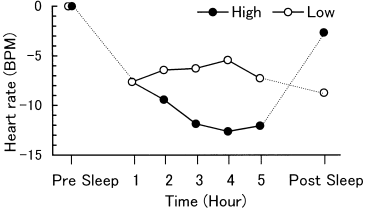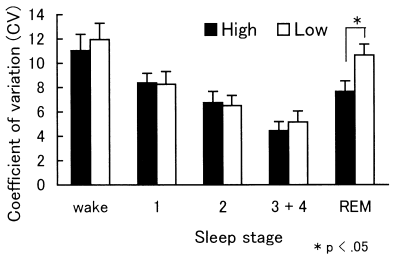Nocturnal heart rate and volitional lifestyle in the elderly
Abstract
Abstract The relationship between the level of volitional lifestyle and nocturnal heart rate (HR) in the elderly was investigated. Twenty high- and low-volitional elderly individuals (n = 10 each; mean age 73.2 years) participated in the study. Heart rate during nocturnal sleep was recorded at their homes using an ambulatory polysomnographic system. High-volitional individuals showed a lower HR throughout the night and less variability during rapid eye movement sleep. These findings suggest that a volitional lifestyle of the elderly has a beneficial effect on autonomic activity during sleep.
INTRODUCTION
The majority of elderly people are concerned about their sleep. It is well known that the depth and continuity of nocturnal sleep deteriorates with aging from early adulthood to senescence; however, a previous study we conducted showed that the ‘volitional’ level of elderly people correlated positively with the subjective and objective quality of nocturnal sleep assessed by post-sleep questionnaires and electroencephalography.1 In the present study, we further examined autonomic activity during nocturnal sleep by recording heart rate (HR).
METHOD
Ten high-volitional and 10 low-volitional individuals participated in two non-consecutive night experiments. They were the same participants as those of our previous study.1 A comparison between both groups demonstrated significantly different scores for the Philadelphia Geriatric Center (PGC) morale scale2 and self-confidence scale.3 The participants also completed an Okawa’s sleep health questionnaire,4 which showed that they had no history of sleep or psychiatric disorders and were not using sedatives. All subjects gave their written informed consent and were paid. A polysomnogram was recorded at the participants’ homes using an ambulatory monitoring system. An electrocardiogram was recorded bipolarly from the left clavicle and the right wrist. Heart rate (b.p.m.) was calculated from R–R intervals. Moreover, the variability of HR was indexed by a coefficient of variation [CV = (SD/mean) × 100]. Sleep stages were scored visually every 30 s according to the criteria of Rechtschaffen and Kales.5 Data from the second night were used for analysis.
RESULTS
High-volitional individuals had better nocturnal sleep than low-volitional individuals; that is, nocturnal awakening was shorter, slow-wave sleep was longer, electroencephalogram (EEG) delta power in the first sleep cycle was higher, and their mood upon rising was better.1Figure 1 shows the changes in HR calculated every hour after sleep onset. Participants in the high-volitional group showed a gradual decrease in HR during sleep, whereas those in the low-volitional group maintained a higher HR throughout the night. A Group × Time ANOVA showed a significant interaction, F3,57 = 2.60, P < 0.01, ɛ = 0.044. The effect of time was significant only for the high-volitional group, F3,23 = 3.77, P < 0.05, ɛ = 0.285.

. Relative variation of temporal behavior of relative changes in heart rate (HR; b.p.m.) during nocturnal sleep. The HR in the presleep period was used as the baseline.
Figure 2 shows the variability in HR at each sleep stage. A Group × Sleep Stage ANOVA showed a significant stage effect, F2,43 = 18.85, P < 0.01, ɛ = 0.060. Although the CV did not differ between the groups during non-rapid eye movement (NREM) sleep, post-hoc comparison showed that low-volitional individuals showed a larger CV compared with high-volitional individuals during REM sleep (P < 0.05).

. The variability of heart rate in each sleep stage during nocturnal sleep.
DISCUSSION
The present study showed that HR during nocturnal sleep was lower for high-volitional than for low-volitional elderly participants. In normal individuals, HR and blood pressure decrease at night and increase during the daytime by adjusting the balance between parasympathetic and sympathetic nervous system functions.6 This balance may be more intact in high-volitional elderly people. Moreover, high-volitional elderly participants showed a stable HR during REM sleep. A volitional lifestyle may serve to keep autonomic activity at night-time at a level suitable for sleep and prevent frequent nocturnal awakenings. However, it cannot be denied that low-volitional individuals might have some diseases such as lacunar infarction and non-dipper that were not assessed by the present study.6 This issue will be explored in further research.




